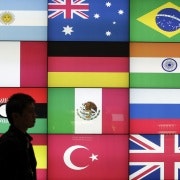Trade wars producing PV pain
While much attention has been focused on the recent imposition of preliminary duties by the European Commission on Chinese solar products, developments in solar trade disputes have been continuing globally.
Aside from Europe, there are now more than 20 countries, representing more than 150 GW of probable end-market demand through 2017, which are either in some phase of a trade dispute or have policies in place – such as domestic content restrictions/bonuses – that leave them open to future dispute expansion. Also, the European case is still active and will not be finalised for several months, representing another possible 60 GW of PV module demand that could be impacted.
In the Western Hemisphere, both the US and Canada have reached final stages in their respective trade disputes, with the US having imposed duties on Chinese-produced c-Si cells and the Canadian province of Ontario having acknowledged that its domestic content requirements (DCRs) must be changed to comply with a World Trade Organization ruling.
Meanwhile, in Latin America, many countries are just now starting to see the possibility of high PV end-market demand growth. Some are acting to boost domestic manufacturing to serve that demand, either by imposing tariffs on imported solar goods or directly supporting domestic manufacturers.
Most of the demand in Latin America is still in its early stage but, given the favourable economic and environmental conditions for PV projects, high growth is expected; as demand picks up, challenges to any policies that attempt to close markets to outside products will likely begin also.
In the Middle East and Africa, local content and manufacturing bases have been the explicit goals of several countries that are planning on installing tens of gigawatts of PV projects over the next decade. Again, many of these programs are just now starting, but any further moves to exclude major foreign firms could further expand the web of trade disputes.
In South Asia, recent proposals coming out of India in regards to its own DCRs are causing concern and uncertainty. Policymakers are suggesting that future rounds of the national solar program may be split into DCR and non-DCR tranches in an effort to appease both domestic manufacturers and potentially head-off a WTO investigation instigated by the US.
At the same time, India is still pursuing its own anti-dumping investigation into Chinese, Malaysian, Taiwanese, and US manufactured PV cells. China has reacted to the initial European duties by starting investigations into European products such as wine and automobiles as well as continuing the long-standing polysilicon investigation.
Unfortunately for the PV industry, many of these disputes continue to intensify. With both national and international bodies involved in the solar industry, this uncertainty is likely to continue for some time. This makes understanding the global picture extremely important for both upstream and downstream PV players.
Companies must now focus on price and quality of PV products, as well as origin and destination in order to minimise any duties. The eventual fallout of these disputes could be dramatic and is certain to reorder the supply and demand dynamics within what is already a fast-moving industry environment.
This article was originally published by SolarBuzz. Republished with permission.













